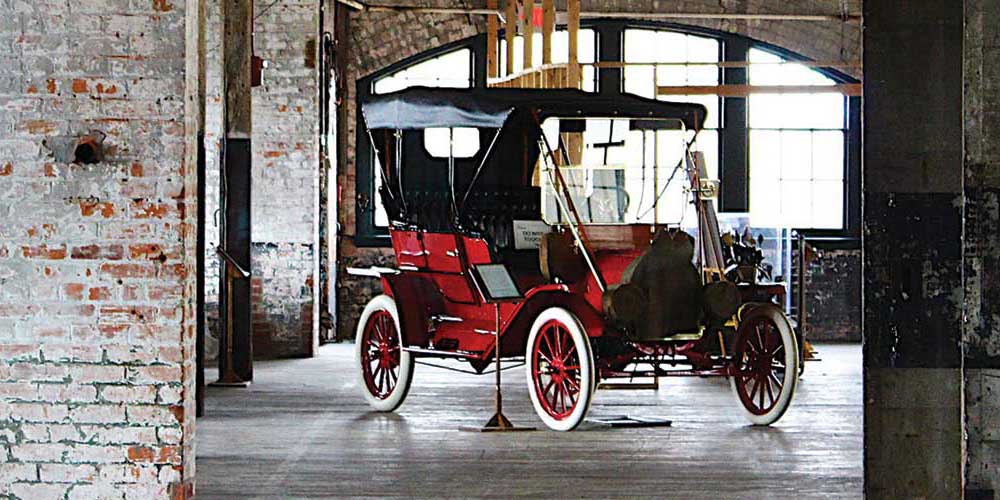Written by: Robert Tate, Automotive Historian/Researcher
Images: Courtesy of The National Automotive History Collection
Posted: 05.20.2015
This is a story about the great accomplishments and contributions of the late Mr. William Bushnell Stout. Mr. Stout was a great American Aviation Engineer who liked to be called an “imaginer”. Scout, was born in 1880 in Quincy, Illinois. He attended Mechanical Arts High School in St. Paul Minnesota and later helped to develop and build one of the first model airplanes in the country. He was considered to be something like a genius.
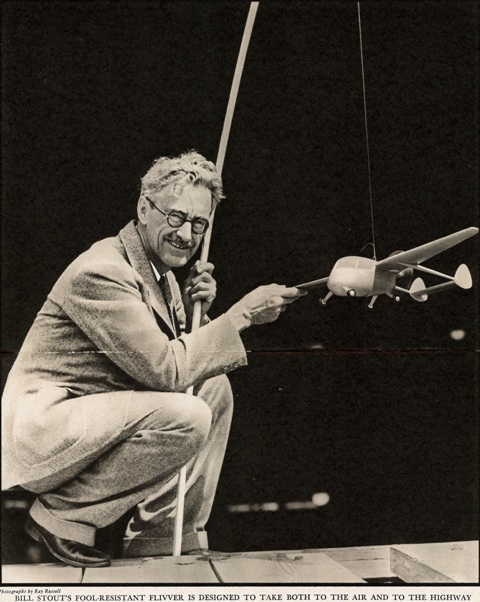 Bill Stout
Bill Stout
In 1914, Mr. Stout started working with the Scripps-Booth Automobile Company to design and create a new motorcycle. He also, however, created the company's first automobile (The Scripps Booth car). This was a full size vehicle design that featured electric door locks, electric starter, and a built in trunk area. The vehicle attracted considerable acclaim and brought Mr. Stout to the attention of Mr. Alvin McCauley. In 1916, Stout started working for Packard and became General sales manager, and later Chief Engineer for the aircraft division working on the V-12 Liberty Engine. He later traveled to Washington as an advisor to the National Aircraft Board.
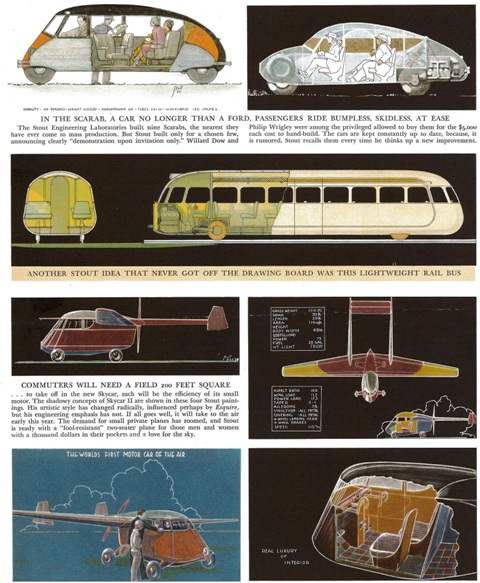 Bill Stouts Engineering Proposals
Bill Stouts Engineering Proposals
This man was a great pioneer in aviation who started the first exclusively passenger airline in the country. He also founded the Stout Engineering Laboratories after the war. Mr. Stout was also the President of the Society of Automotive Engineers for some time. Stout went on to establish the Stout Motor Car Corporation which was located at 2124 South Telegraph road in Dearborn, Michigan. Later, Stout founded the Stout Metal Airplane Co; which later he sold to the late Henry Ford in 1926. In 1935, Mr. Stout, designed and built the famous rear-engine Scarab automobile. Nine models were produced. The models, however, demonstrated a challenge in the automotive industry regarding traditional design changes and their impact on the consumer market.
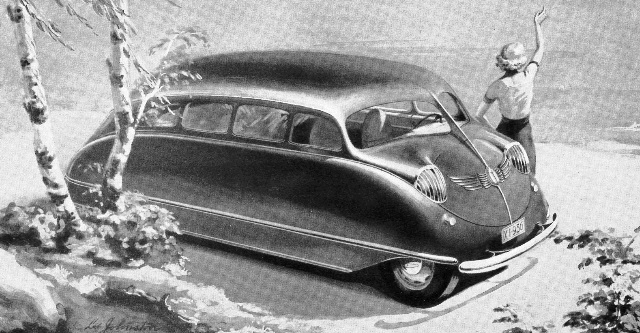 1936 Scarab Advertising
1936 Scarab Advertising
Mr. Stout produced a vehicle that was roomier than the largest automobile. Yet, its overall dimensions and its weight could compare with the smallest of the popular automobiles. In riding quality and many other features the vehicle was very unusual in design. A comfortable chair was offered for the driver. The model could accompany anywhere between four to seven adults for long term traveling and if a passenger wished to sleep while another passenger was driving a full-length bed was available for that special rest time. The doors of the new Scout could open by a pressing electric push button mechanism that was designed for easy operation. The new Stout-Scarab motor car was designed with a rear engine mounting and a body designed to facilitate easy driving for the motorist. Some historians have said that the Stout was the first rear-end American design.
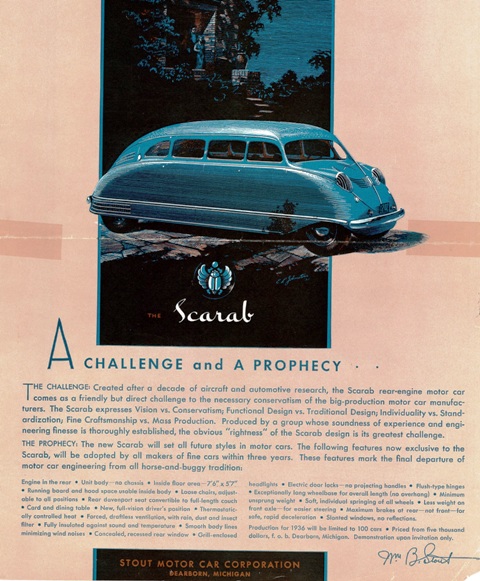 Scarab Advertising
Scarab Advertising
Other features included deleted running boards; a flush glass area design that was offered for its passengers and rear wheel skirts along with leather seats for passengers was a great idea for future design proposals. The model also offered a heating controlled thermostat along with power door locks for one’s driving pleasure. Some automotive historians have said that the Scarab model design was the first minivan concept however some would disagree. On the interior, the seating was arranged for cross-country travel with movable chairs and a couch that allowed passengers to shift positions if needed. The feeling of the interior was like that of a small yacht or motor boat. The Scarab design was in allusion to the Egyptian sacred beetle, to describe its shape, not its speed. The first Scarab design was completed in 1932. It was never intended for production, but rather a concept model that would spark the imagination of other engineers.
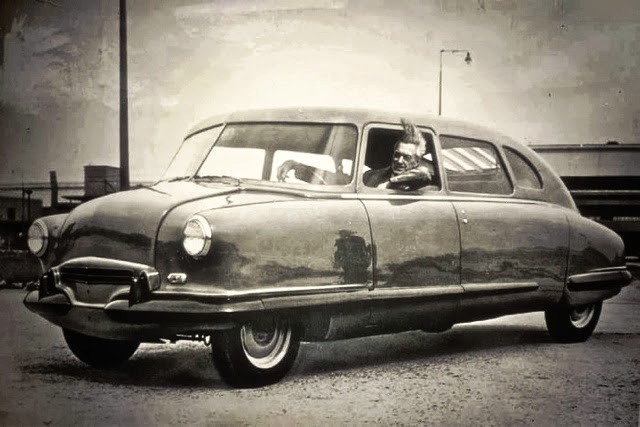
The second Stout model (1944) was made out of fiberglass and described by the inventor as the car for the future. There were no axles or chassis and the engine was located in the rear. The body could not be dented with a hammer or any other type of object. The interior was practically a small room with the floor measuring 6 feet wide and 11 feet long. The Stout Scarab III was built by the Owens/Corning in 1944-46 and the model was later donated to the Detroit Historical Museum in 1951.
On March 20, 1956 at the age of 76, Mr. Scout passed away. Today, Mr. Stout is remembered as a great pioneer in aviation, a man who started the first exclusively passenger airline in the country, and the man paved the way for future automotive innovations. For this, Mr. William Bushnell Stout and his accomplishments will always be a part of our automotive heritage.
A special thanks to Robert Tate, Automotive Historian and Researcher, for donating the story to the MotorCities Story of the Week program. Photographs are courtesy of the National Automotive History Collection. (Bibliography: Duncan Robert “Streamlined Futures” Today magazine July 4, 1936. Motor Magazine “New Stout-Scarab is Handsome Rear-engine Car” November 1935.)
For further information on photos please visit http://www.detroitpubliclibrary.org/ or email This email address is being protected from spambots. You need JavaScript enabled to view it.. Please do not republish the story and/or photographs without permission of MotorCities National Heritage Area.
If you would like to contribute an article for the MotorCities newsletter, email This email address is being protected from spambots. You need JavaScript enabled to view it. or call 313-259-3425.


